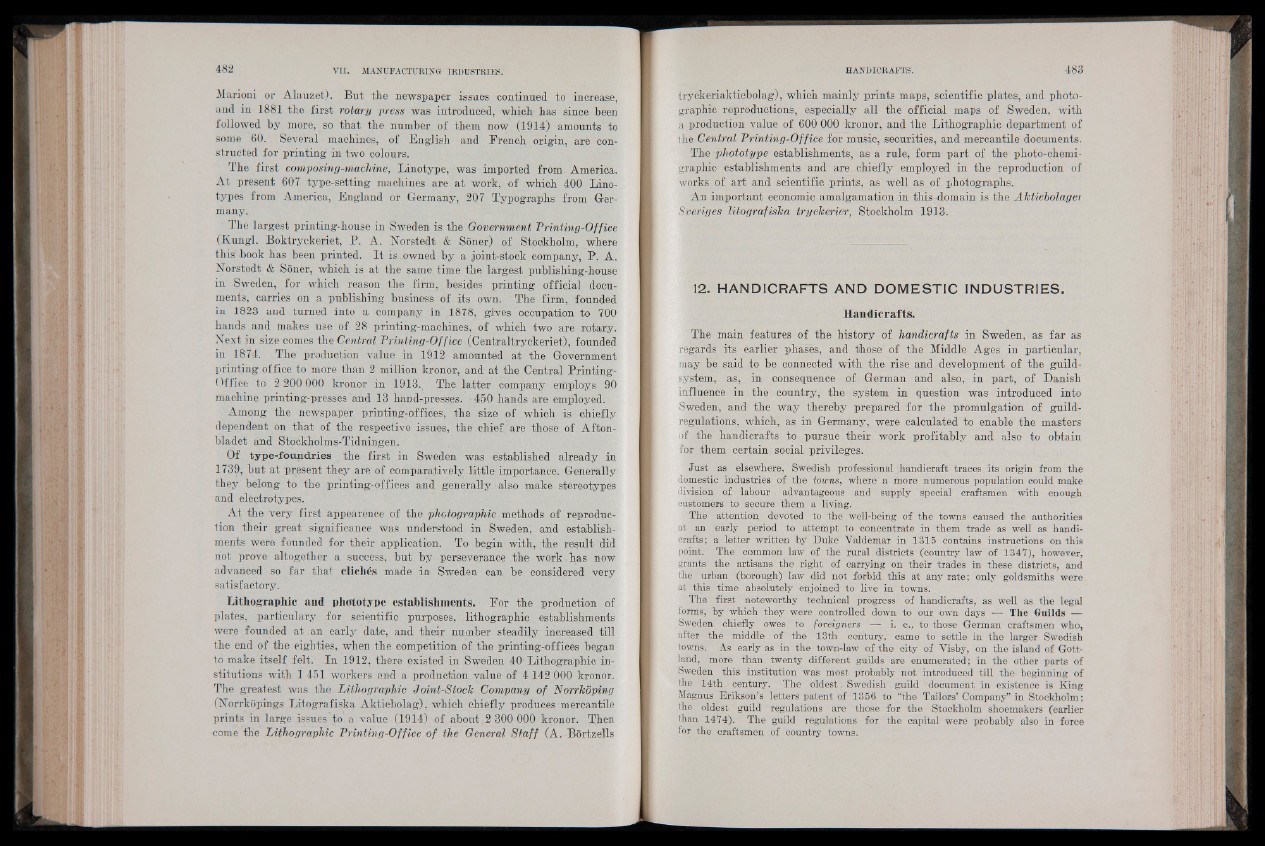
Marioni or Alauzet). But the newspaper issues continued to increase,
and in 1881 the first rotary press was introduced, which has since been
followed by more, so that the number of them now (1914) amounts to
some 60. Several machines, of English and French origin, are constructed
for printing in two colours.
The first composing-machine, Linotype, was imported from America.
At present 607 type-setting machines are at work, of which 400 Linotypes
from America, England or Germany, 207 Typographs from Germany.
The largest printing-house in Sweden is the Government Printing-Office
(Kungl. Boktryckeriet, P. A. Norstedt & Sôner) of Stockholm, where
this book has been printed. It is . owned by a joint-stock company, P. A.
Norstedt & Sôner, which is at the same time the largest publishing-house
in Sweden, for which reason the firm, besides printing official documents,
carries on a publishing business of its own. The firm, founded
in 1823 and turned into a company in 1878, gives occupation to 700
hands and makes use of 28 printing-machines, of which two are rotary.
Next in size comes the Central Printing-Office (Centraltryckeriet), founded
in 1874. The production value in 1912 amounted at the Government
printing office to more than 2 million kronor, and at the Central Printing-
Office to 2 200 000 kronor in 1913,, The latter company employs 90
machine printing-presses and 13 hand-presses. -450 hands are employed.
Among the newspaper printing:offices, the size of which is chiefly
dependent on that of the respective issues, the chief are those of Afton-
bladet and Stockholms-Tidningen.
Of type-foundries the first in Sweden was established already in
1739, but at present they are of comparatively little importance. Generally
they belong to the printing:offices and generally also make stereotypes
and electrotypes.'
At the very first appearence of the photographic methods of reproduction
their great significance was understood in Sweden, and establishments
were founded for their application. To begin with, the result did
not prove altogether a success, but by perseverance the work , has now
advanced so far that clichés made in Sweden can be considered very
satisfactory.
Lithographic and phototype establishments. For the production of
plates, particulary for scientific purposes, lithographic establishments
were founded at an early date, and their number steadily increased till
the end of the eighties, when the competition of the printing-offices began
to make itself felt. In 1912, there existed in Sweden 40 Lithographic institutions
with 1 451 workers and a production value of 4 142 000 kronor.
The greatest was the Lithographic Joint-Stock Company of Norrhoping
(Norrkôpings Litografiska Aktiebolag)r which chiefly produces mercantile
prints in large issues to, a.value (1914) of about 2 300 000 kronor. Then
come the Lithographic Printing-Office of the General Staff (A. Bôrtzells
tryckeriaktiebolag), which mainly prints maps, scientific plates, and photographic
reproductions, especially all the official maps of Sweden, with
a production value of 600 000 kronor, and the Lithographic department of
the Central Printing-Office for music, securities, and mercantile documents.
The phototype establishments, as a rule, form part of the photo-chemi-
graphic- establishments and are chiefly employed in the reproduction of
works of art and scientific prints, as well as of photographs.
An important economic amalgamation in this domain is the Aktiebolagei
Sveriges litografiska tryckerier, Stockholm 1913.
12. HANDICRAFTS AND DOMESTIC INDUSTRIES.
Handicrafts.
The main features of the history of handicrafts in Sweden, as far as
regards its; earlier phases, and those of the Middle Ages in particular,
may be said to be connected with the rise and development of the guild-
system, as, in consequence of German and also, in part, of Danish
influence in the country, the system in question was introduced into
Sweden, and the way thereby prepared for the promulgation of guild-
regulations, which, as in Germany, were calculated to enable the masters
of the handicrafts to pursue their work profitably and also to obtain
for them certain social privileges.
Just as elsewhere, Swedish professional ¿handicraft traces its origin from the
domestic industries of the towns, where a more numerous population could make
división oí labour advantageous and supply special craftsmen with enough
customers to secure them a living.
The attention, devoted tó the well-being of the towns caused the authorities
at an early period to attempt to concentrate in them trade as well as handicrafts;
a letter written by Duke Valdemar in 1315 contains instructions on this
point. The common law of the rural districts (country law of 1347), however,
grants the artisans the right of carrying on their trades in these districts, and
the urban (borough) law did not forbid this at any rate; only goldsmiths were
at this time absolutely enjoined to live in towns.
The first noteworthy technical progress of handicrafts, as well as the legal
forms, by which they were controlled down to our own days •— The Guilds —
Sweden chiefly owes to foreigners — if e., to those German craftsmen who,
after the middle oí the 13th century, came to settle in the larger Swedish
towns. As early as in the town-law of the city of Visby, on the island of Gott-
land, more than twenty different guilds are enumerated; in the other parts of
Sweden this institution was most probably not introduced till the beginning of
the 14th century. The oldest, Swedish guild document in existence is King
Magnus Erikson’s letters patent of 1356 to “the Tailors’ Company” in Stockholm;
the oldest guild regulations are those for the Stockholm shoemakers (earlier
than 1474). The guild regulations for the capital were probably also in force
for the craftsmen of country towns.